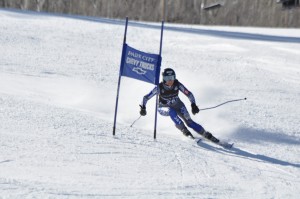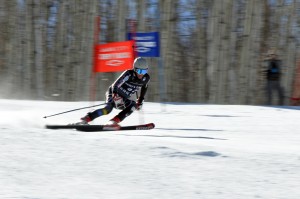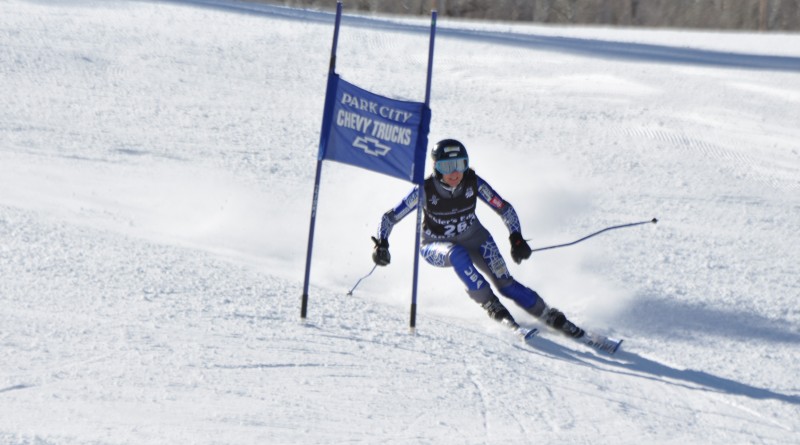Ski Faster! 7 Tips Guaranteed to Make You a Better Racer

Skiing down a race course as fast as you dare is one of Alpine skiing’s sweetest adrenaline rushes. After the first time or two, if you have an ounce of competitive nature, the challenge of how to go even faster inevitably kicks in. There are ski races every day in Vermont during the winter. Whether you’re competing for beer league bragging rights or a NASTAR (National Standard Race) gold, chasing points as a junior, or trying to cuts 10ths off your time on the masters circuit, everyone who enters a race feels the need for more speed. If you’re sick of finishing second, here are seven tips guaranteed to improve your performance:
Start faster. Many racers lose up to two seconds between the starting gate and the first turn. The two most common mistakes are (1) putting your poles too far in front of your feet and (2) using all arms and shoulders to push through the timing wand. Point your ski tips toward the first gate, then place your ski poles over the wand, planting them firmly enough for a strong push, but not so firmly they get stuck. Bring your shins close to the wand, then bend your knees and coil your body like a cheetah about to pounce. On “go,” push forward using your legs, core, and upper body as you open the wand. Continue pushing until you no longer accelerate forward from the effort or until you reach the first gate.
Look ahead. The least intuitive part of ski racing is looking two or more gates ahead. You naturally want to look at the gate you’re heading toward, but if you look gate to gate, you’ll feel rushed and likely get later and later. In general, you should place two-thirds of your turn above the gate, which is only possible if your eyes are focused down the hill. As you stand in the start, look past the first gate to the second and third gates, then keep doing it all the way to the finish. In other words, if you are turning around a blue gate, look past the next (red) gate to the following blue gate, farther if you can. If you look ahead, you’ll not only ski a better line, you’ll feel as if you have a lot more time to react.
Apply forward pressure. All modern skis need to engage the tip at the top of each turn to start the ski carving and to prevent chatter. If you slam all your weight into the middle of the ski, your edges may bite briefly but you won’t be fast. Drive pressure onto the tip of your outside (downhill) ski by flexing hard at the ankle against the inside corner of your ski boot tongue. After you feel the tip engage, then allow pressure to build under your foot.

Keep your hands forward. Another common mistake is dropping the hand closest to the gate as you pass by, or worse, dropping both hands. The former causes pressure to leave the downhill ski. The latter causes your shins to lose contact with your boot tongues. The result in both cases is a slow skidding ski. Fast racers keep their hands forward, and if they get thrown off their line, they drive their hands forward to regain their balance. Be aware of the “zombie position,” holding your arms stiffly forward. The fastest ski racers appear fluid and agile. Likewise, avoid steering with your hands around each turn, which releases the pressure from the downhill ski.
Keep a calm upper body. Ski racing requires you to be strong all over, not just in your legs. You may steer with your feet and power through each turn with your legs, but it takes a strong upper body to hold your torso and arms quietly as your feet move side to side. Too much upper body movement is not only nonaerodynamic and a waste of energy but can also throw off your balance and your ability to carve turns.
Carve, don’t skid. A carved turn that leaves two railroad tracks on the snow is a much faster turn than a skidded one. In a carved turn, your skis roll up on edge. The higher the edge angle, the higher performance the turn is. Many ski racers try to stay low or in a tuck, thinking it’s more aerodynamic and thus faster. In fact, it’s much faster to carve a good turn than to tuck. Tuck if you can, but as soon as you feel the slightest skid, pick up your chest and make a good turn.
Finish Faster. You don’t have to go through the middle of the finish! You can cross the line anywhere. After you pass the last gate, if you let your skis runs straight, you’ll gain a few 10ths over the others who arc toward the middle of the finish line.
GET INVOLVED
Looking for a place to pick up your ski-racing pace? Most ski areas in Vermont host local ski leagues. There are also myriad charity races, and most mountains are home to at least one ski club or mountain-administered race program. The following organizations can help you explore your options:
United States Ski and Snowboard Association: The national governing body for ski racing in the United States. Contact USSA for information on junior and masters racing (age 18 and older) and for a list of affiliated ski clubs.
Vermont Alpine Racing Association: Coordinates USSA-sanctions ski racing in Vermont, particularly at the junior level.
New England Masters Skiing: Coordinates USSA-sanctioned masters-level racing in Vermont for adults aged 18 and up.
NASTAR: Entry-level age-group competition, open to the public at specific ski areas. Note: Some ski areas offer NASTAR-style ski racing without the NASTAR name. Go to the skier-services desk at a particular ski area to find out what’s available.
Vermont Ski Areas Association: For contact information and a schedule of events at each ski area in Vermont.

